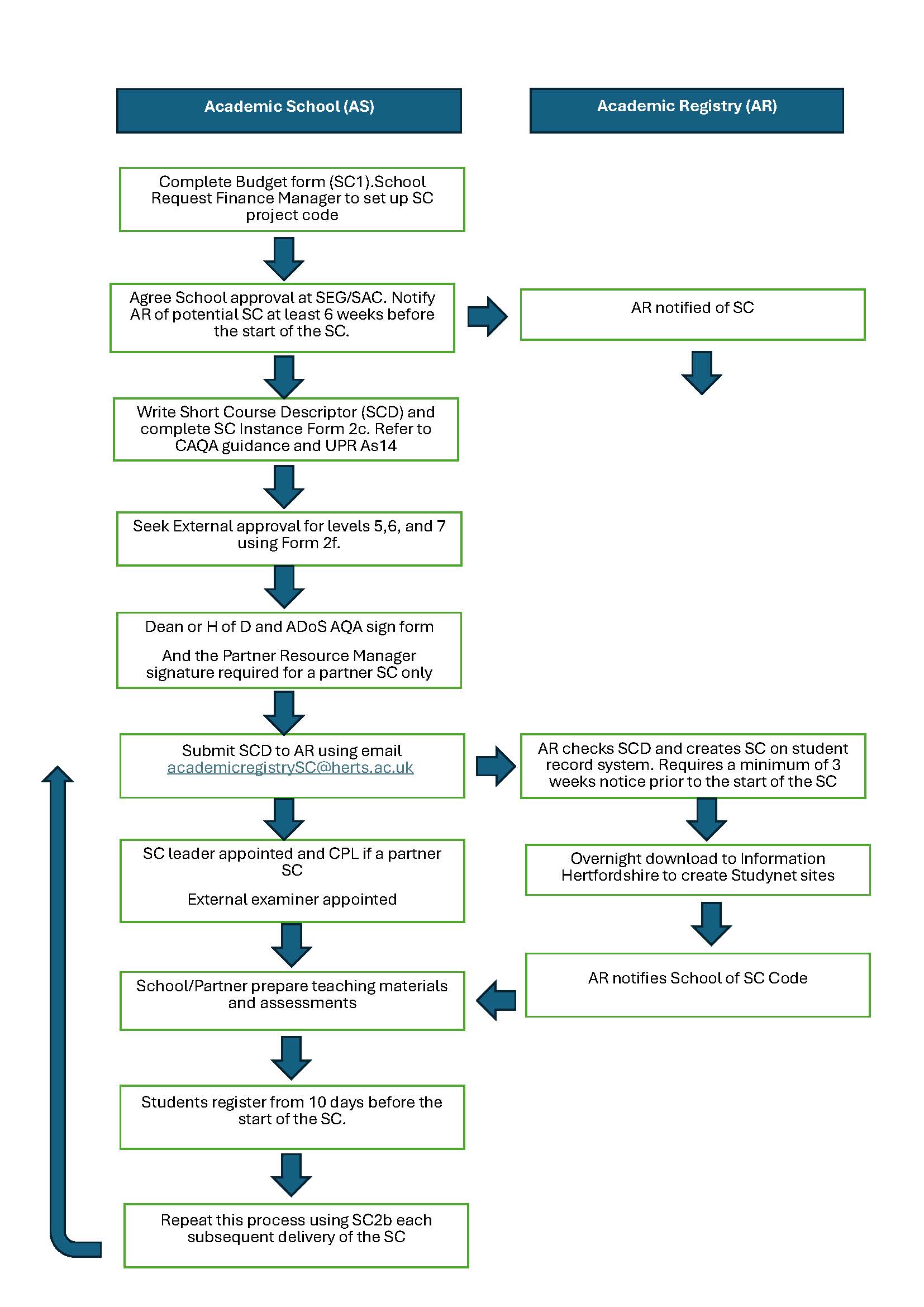Credit-bearing Short Courses
Credit Bearing Short courses are seen as a key feature of the University’s business-facing strategy and are provided in response to business demand for workforce development. They are credit-rated in order that participants may have the opportunity to achieve HE credit and the potential to build credit to an award (for information on awards available, see 'Awards available on flexible study routes' ). Zero credit short courses are not part of the Flexible Credit Framework.
An important reference point is UPR AS14 Structure and Assessment Regulations (Undergraduate and Taught Postgraduate).
A credit-bearing short course (SC) is defined by the University as a self-contained unit of study, with defined intended learning outcomes, syllabus and assessments which measure these outcomes. It is not part of a defined programme of study leading to a University of Hertfordshire award, as defined in UPR GV08 (Glossary of Approved Terminology), but the credit achieved may contribute to a UH award through the CATS programme – see the information on Awards available to students on flexible study routes .
There are some differences between a credit-bearing short course and module. A module is defined as a self-contained unit of study which is part of a validated programme of study. A short course should therefore only be developed if it is not already delivered as part of a University programme or if it is intended to have non-standard units of credit (i.e. 5, 10, 20 or 25 credits). If it is intended that an existing module attached to a University programme is also offered as a standalone course, then the existing Definitive Module Document (DMD) should be used rather than developing a separate short course descriptor (SCD).
Short course development and approval
The key to the rapid approval of credit-bearing short courses is the creation of a short course descriptor (SCD). This document:
- Enables the course to be formally approved;
- Provides the necessary data for the student record system; and
- Provides the information for a website entry.
The generic level descriptors, SEEC Level Descriptors 2021 are used to indicate the level of the short course.
There is a series of SCD templates for levels 4, 5, 6, and 7, which can be accessed by Herts staff on HertsHub (requiring login).
The short course approval process is shown in the flow chart below. Please get in contact with the CAQA team if you need any further information. The team can also be contacted if an accessible version of this diagram is needed.
All forms referred to are available to Herts staff on HertsHub (requiring login).

Short Course Admissions, Delivery and Quality Assurance
A flowchart for Short Course admissions, delivery and quality assurance is presented here. Please get in contact with the CAQA team if you need any further information.
All short courses have a record on the student record system, enabling them to be viewed through the University’s website. Learners can select, register and pay for the course on-line, which then creates a student record on the student record system. Downloads of learner data are made overnight, so that learner accounts can be created (so allowing the option of StudyNet, short course-specific websites, Student ID card and a UH e-mail account to be accessed).
All credit-bearing short courses at levels 5, 6 and 7 have an external examiner assigned to them. The following fee structure has been agreed for external examiners for short courses. The fee is payable by the School:
- £50 per delivery of a short course, up to a maximum of £400pa, with up to 20 deliveries of a short course (or modules) per external per annum.
A short course external examiner is expected to carry out the following duties:
- Approve proposed assessments (plus model solutions);
- Review a sample of marked assessments (but have the right to see all scripts);
- Be consulted about any proposed changes to the short course;
- Report to the University annually (using the standard Module external examiner’s report template, maintained by Academic Services).
For short courses that are delivered several times a year, then not all instances need to be externally moderated:
- One instance should be moderated for 1-2 instances of the short course per annum;
- Two instances should be moderated for 3-5 instances of the short course per annum;
- Three instances should be moderated for 6+ instances of the short course per annum.
Credit awarded for short courses will be confirmed through the Short Course Board identified on the SCD. Regulations for operation of Short Course Boards, award of credit, etc. are described in UPR AS14. Short Course Boards can be operated in conjunction with Module Boards, unless volume warrants separate Short Course Boards (see C2.1 and C2.2 of UPR AS14).
For the purposes of annual monitoring of credit-rated short course activity, an Annual Short Course Monitoring Report (ASCMR) is used. A template is available for Herts staff on HertsHub (Herts login required), for use by (i) UH Schools and (ii) externally-accredited partners of UH, to report on credit-rated short course activity over the previous year. If a School’s (or externally-accredited partner’s) short course activity is sufficiently large and complex, then more than one annual report may be appropriate, but the normal expectation is one ASCMR per School or per partner, annually. These ASCMRs will be submitted to SAC for consideration and approval, alongside programme AMERs. Any significant and recurring issues may be reported in the School’s annual report to the Education and Student Experience Committee (ESEC) and to the Academic Standards and Audit Committee (ASAC).
Review of credit bearing short courses
Short courses that are regularly repeated should be reviewed using a risk-based approach and follow the school-based review approach.
All forms referred to are available for Herts staff on the HertsHub site (Herts login required):
Appendix 2B: Short Course Descriptor (Levels 4/5/6/7 and non-credit bearing)
Appendix 2C: Short Course Instance Form
Appendix 2D: Short Course Descriptor - Guidance Notes
Appendix 2E: End of Short Course Evaluation Form
Appendix 2F: Accredited short course review template
Appendix 2G: Short Course External Examiner Approval Form







